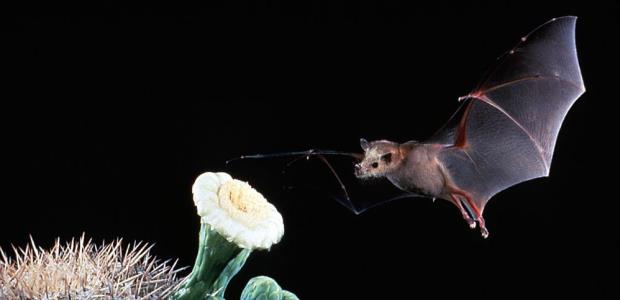
Lesser Long-Nosed Bat Recovering, Delisting Proposed
With 30 years of recovery efforts having paid off, the U.S. Fish and Wildlife Service is proposing to remove the bat from the Endangered Species Act's protections.
Considering that news about bats is generally bad, a Jan. 5 U.S. Fish and Wildlife Service release saying the lesser long-nosed bat is bucking the trend is good news. "The story of how this southwestern pollinator recovered from historic lows to the point where it could today be proposed for removal from the federal list of endangered and threatened wildlife exemplifies the power of the Endangered Species Act in driving collaborative conservation. And it shows just how well the ESA works when given the time and resources to do so," according to FWS.
"When initially protected under the ESA in 1988, the nectar-feeding lesser long-nosed bat was struggling for survival. Today, vastly improved numbers of bats and roosts in the U.S. Southwest and Mexico have conservation partners anticipating that their 30-year recovery efforts have paid off. In 1988, there were thought to be fewer than 1000 bats at the 14 known roosts range wide. There are now an estimated 200,000 bats at 75 roosts. Consequently, the U.S. Fish and Wildlife Service is proposing to remove the bat from the ESA's protections," it states.
The release quotes FWS Arizona Field Supervisor Steve Spangle: "This has been an international team effort involving citizen scientists in Pima County, tequila producers in Mexico, biologists in both the U.S. and Mexico, non-governmental organizations and federal and state agencies, all pulling together under the organizing banner of the Endangered Species Act. These collaborative efforts have succeeded in recovering this important pollinator and seed disperser, contributing to healthy soils and habitats, and providing sustainable economic benefits for communities."
It says Mexican tequila producers who cultivate agaves are increasingly integrating harvest and cultivation practices in recognition that agaves rely on bats for pollination and are even marketing "bat friendly" tequila. "Historically, the control of vampire bats for rabies vector control and to reduce impacts to the livestock industry, destroyed roost sites of non-target bats like the lesser long-nosed bat. An active education campaign to change attitudes regarding the conservation of bats and improved bat identification is showing success in long-nosed bat conservation. As a result of reduced threats and the positive lesser long-nosed bat population response, the bat was removed Mexico's endangered species list in 2015," it says.
Lesser long-nosed bats range from southern Mexico to southern Arizona and New Mexico. Some Mexican populations are year-round residents but some are migratory.
If the lesser long-nosed is delisted, FWS would continue to work with partners to monitor its status for a minimum of five years after delisting. A post-delisting monitoring plan will describe monitoring methods, reporting procedures and agency responsibilities, and be published as a draft for public comment prior to the final delisting rule.
To comment on the proposed delisting, visit http://www.regulations.gov and search for FWS–R2–ES–2016–0138, the docket number for the rulemaking.